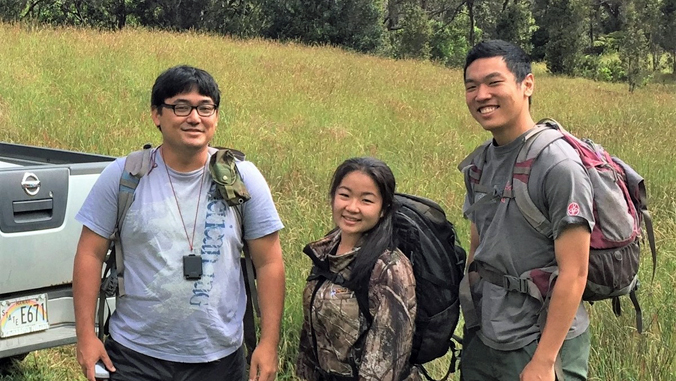
Researchers at the University of Hawaiʻi at Hilo waited 25 years for field results from a study investigating whether or not Hawaiʻi Island’s higher-elevation tropical forests could rejuvenate after destructive cattle and pigs were fenced out.
The study was conducted by UH Hilo scientists Patrick J. Hart, Thomas Ibanez, Shea Uehana and Joshua Pang-Ching, whose research paper was published in January in Restoration Ecology. The scientists’ research of new and thriving growth of keiki ʻōhiʻa and koa in the studied area is good news about the forests’ native trees and the threatened bird species for whom the trees provide habitat.
Preserving wet forest

In 1985, Hakalau Forest National Wildlife Refuge was established to preserve approximately 13,000 hectares of higher-elevation wet forest that had been impacted by cattle and pigs. The conservationists fenced off large tracts of the preserve and by 1992 had removed all remaining cattle, most of which had become feral.
In the mid-1990s, after the cattle were removed, Hart, who at the time was a doctoral student studying the refuge as a bird habitat, measured and tagged 7,000 trees in some of the fenced-off areas. For the 2020 paper, Hart and his colleagues returned to the same areas he had studied 25 years earlier.
“When we returned to those areas, we found 4,000 new recruits [young trees] 5 cm in diameter in those same plots,” said Hart. “Going up there 25 years ago you would see mostly medium to large trees with very little understory, but now you see lots of keiki.”
The goal of the Hakalau Forest National Wildlife Refuge project was to allow the forest to passively regenerate. The new paper by Hart and his colleagues demonstrates that the refuge has been largely successful.
“The fencing allowed this new cohort of (Acacia) koa trees to come up just in time,” he said. “The koa trees get big, they grow fast, and can live for 200 years, so they’re very important for the bird species up there.”
Hart noted that the reason the restoration was successful without active management may be because the forest had not yet been completely converted into grassland, and there was still relatively intact forest left nearby, which helped the native trees to come back on their own.
For more details, visit UH Hilo Stories.
—By Leah Sherwood, a graduate student in the tropical conservation biology and environmental science program at UH Hilo

